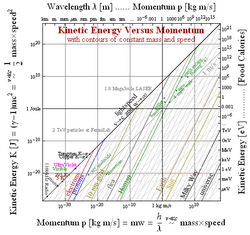Physics:Planck momentum

Planck momentum is the unit of momentum in the system of natural units known as Planck units. It has no commonly used symbol of its own, but can be denoted by [math]\displaystyle{ m_\text{P} c }[/math], where [math]\displaystyle{ {m_\text{P}} }[/math] is the Planck mass and [math]\displaystyle{ c }[/math] is the speed of light in a vacuum. Then
- [math]\displaystyle{ m_\text{P} c = \frac{\hbar}{l_\text{P}} = \sqrt{\frac{\hbar c^3}{G}} \approx 6.52485\text{ kg m/s}, }[/math]
where
- [math]\displaystyle{ \hbar }[/math] is the reduced Planck's constant,
- [math]\displaystyle{ {l_\text{P}} }[/math] is the Planck length,
- [math]\displaystyle{ G }[/math] is the gravitational constant.
In SI units Planck momentum is approximately 6.5 kg·m/s. It is equal to the Planck mass multiplied by the speed of light, usually associated with the momentum of primordial photons in some prevailing Big Bang models. Unlike most of the other Planck units, Planck momentum occurs on a human scale. By comparison, running with a five-pound object (108×Planck mass) at an average running speed (10−8×speed of light in a vacuum) would give the object Planck momentum. A 70 kg human moving at an average walking speed of 1.4 m/s (5.0 km/h; 3.1 mph) would have a momentum of about 15 [math]\displaystyle{ m_\text{P} c }[/math]. A baseball, which has mass [math]\displaystyle{ m= }[/math] 0.145 kg, travelling at 45 m/s (160 km/h; 100 mph) would have a Planck momentum.
Notes and references
See also
- Natural units
- Planck's constant
- Orders of magnitude (momentum)

